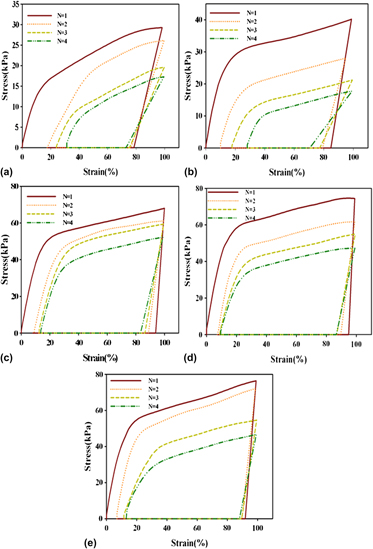Crossref Citations
This article has been cited by the following publications. This list is generated based on data provided by
Crossref.
Gugliuzza, Annarosa
and
Drioli, Enrico
2013.
A review on membrane engineering for innovation in wearable fabrics and protective textiles.
Journal of Membrane Science,
Vol. 446,
Issue. ,
p.
350.
Feng, Xin Ya
Li, Shu Kui
Wang, Yan
Wang, Ying Chun
and
Liu, Jin Xu
2013.
The Effects of SiO<sub>2</sub>/PEG Suspension on Mechanical Properties of Rigid Polyurethane Foams.
Advanced Materials Research,
Vol. 815,
Issue. ,
p.
246.
Gugliuzza, Annarosa
and
Drioli, Enrico
2014.
Smart Membranes and Sensors.
p.
401.
Heck, Cesar A.
Giacomolli, Diego A.
Livotto, Paolo R.
dos Santos, João Henrique Z.
and
Wolf, Carlos R.
2014.
Hybrid silica generated In situ in polyurethane‐based composites.
Journal of Applied Polymer Science,
Vol. 131,
Issue. 23,
Bai, Quanming
Zhang, Gongzheng
Xu, Bo
Feng, Xianqi
Jiang, Haoyang
and
Li, Huanjun
2015.
Thermal and water dual-responsive shape memory poly(vinyl alcohol)/Al2O3 nanocomposite.
RSC Advances,
Vol. 5,
Issue. 111,
p.
91213.
Heck, Cesar A.
dos Santos, João Henrique Z.
and
Wolf, Carlos R.
2015.
Waterborne polyurethane: the effect of the addition or in situ formation of silica on mechanical properties and adhesion.
International Journal of Adhesion and Adhesives,
Vol. 58,
Issue. ,
p.
13.
Xie, Fang
Huang, Longnan
Leng, Jinsong
and
Liu, Yanju
2016.
Thermoset shape memory polymers and their composites.
Journal of Intelligent Material Systems and Structures,
Vol. 27,
Issue. 18,
p.
2433.
Heck, Cesar A.
dos Santos, João Henrique Z.
and
Wolf, Carlos R.
2017.
Hybrid silicas/waterborne polyurethane composite properties: In situ formation vs. grafting methods.
Journal of Sol-Gel Science and Technology,
Vol. 81,
Issue. 2,
p.
505.
Wypych, George
2017.
Handbook of Foaming and Blowing Agents.
p.
29.
Wypych, George
2017.
Handbook of Foaming and Blowing Agents.
p.
195.
Wypych, George
2017.
Handbook of Foaming and Blowing Agents.
p.
179.
Wypych, George
2017.
Handbook of Foaming and Blowing Agents.
p.
123.
Salgado, Cástor
Arrieta, Marina P.
Peponi, Laura
Fernández-García, Marta
and
López, Daniel
2017.
Silica-nanocomposites of photo-crosslinkable poly(urethane)s based on poly(ε-caprolactone) and coumarin.
European Polymer Journal,
Vol. 93,
Issue. ,
p.
21.
Shi, Shuo
Han, Yanting
and
Hu, Jinlian
2019.
Robust waterproof and self-adaptive breathable membrane with heat retention property for intelligent protective cloth.
Progress in Organic Coatings,
Vol. 137,
Issue. ,
p.
105303.
Choi, Hyeon Jun
and
Kim, Jung Hyeun
2020.
Static and dynamic comfort properties of polyurethane foams including a flexible amine crosslinker.
Journal of Industrial and Engineering Chemistry,
Vol. 90,
Issue. ,
p.
260.
Lashkari, Reza
Tabatabaei‐Nezhad, Seyyed Alireza
and
Husein, Maen M.
2021.
Shape Memory Polyurethane as a Drilling Fluid Lost Circulation Material.
Macromolecular Materials and Engineering,
Vol. 306,
Issue. 11,
Wypych, George
2022.
Handbook of Foaming and Blowing Agents.
p.
231.
Wypych, George
2022.
Handbook of Foaming and Blowing Agents.
p.
133.
Couvreur, Rachel
Tamrakar, Sandeep
Savich, Pauline
Mielewski, Deborah
and
Kiziltas, Alper
2022.
Closed‐loop recycling of thermoset composites from electric motor assembly process into flexible polyurethane foams.
Polymer Composites,
Vol. 43,
Issue. 11,
p.
8105.
Wypych, George
2022.
Handbook of Foaming and Blowing Agents.
p.
29.
